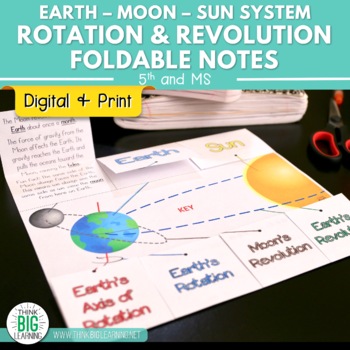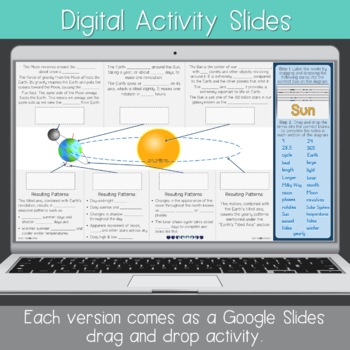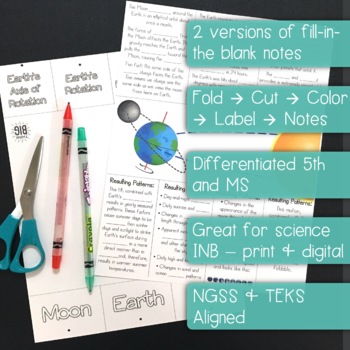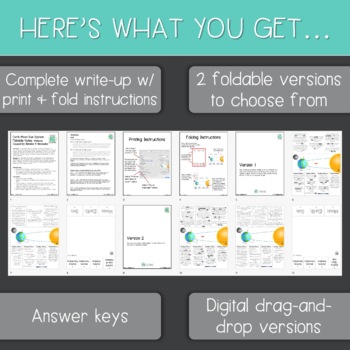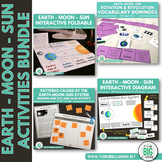Rotation and Revolution in the Earth-Moon-Sun System Foldable Notes
- Zip
- Google Apps™

What educators are saying
Also included in
- Looking for engaging ways to help students with rotation and revolution? This bundle of activities gives multiple methods for students to learn and apply this challenging content related to the patterns we observe in the Earth-Moon-Sun system. Students can read about it using the reading passage andPrice $15.40Original Price $19.25Save $3.85
Description
Engage your students as you teach them about rotation and revolution! This foldable notes page, with printable and digital versions, allows students to identify components of the Sun-Earth-Moon system and explain how the components interact with one another and how their movements impact phenomenon on Earth. The foldable covers the concepts of rotation and revolution within the Sun-Earth-Moon system and the daily, monthly and yearly patterns observed as a result of those movements.
There are two versions of the foldable included in the download, one for elementary use and one for secondary use. You can choose the appropriate level for your students.
Big idea: Our everyday life on Earth is dependent on our relationship with the sun and moon. The interactions between Earth, sun, and moon dictate many cycles we experience, such as day-night cycle, seasons, and the lunar cycle. In addition, the sun is the foundation for the cycling of matter and energy that occurs here on Earth.
What’s Included in This Product
-Two-page foldable at two different levels (elementary and secondary)-digital and printable
-Animated PowerPoint to guide students in completing notes
-Key for notes pages
-Instructional write-up
Other Products You May Like
Earth-Moon-Sun System Interactive Diagram
Earth-Moon-Sun System Reading Passage and Cut-and-Glue
Connect with Think Big Learning
For how-to videos, freebies, and other great ideas:
Like us on Facebook
Follow us on Instagram
Pin with us on Pinterest
Check out our Think Big Learning TpT store
Click the “Follow Me” button next to our store logo/name to receive notification of new products we post as well as sales.
Terms of Use
By purchasing this file, you agree to the following terms. All rights reserved by author. This product is to be used by the original downloader only for personal or classroom use only. Copying for more than one teacher, classroom, department, school, or school system is prohibited. This product may not be distributed or displayed digitally for public view. All graphics and fonts are also protected by copyright from their original author/artist.
Keywords
pattern, cycles, rotation, revolution, Earth, Moon, Sun, tilted Earth, seasons, day-night cycle, lunar cycle, shadow length, tides, foldable, interactive notebook
Standards
NGSS
Core Disciplinary Ideas
• ESS1.B: Earth and the Solar System
o This model of the solar system can explain eclipses of the Sun and the moon. Earth’s spin axis is fixed in direction over the short-term but tilted relative to its orbit around the Sun. The seasons are a result of that tilt and are caused by the differential intensity of sunlight on different areas of Earth across the year (MS-ESS1-1)
• ESS1.B: Earth and the Solar System
o The orbits of Earth around the Sun and of the moon around Earth, together with the rotation of Earth about an axis between its North and South poles, cause observable patterns. These include day and night; daily changes in the length and direction of shadows; and different positions of the Sun, moon, and stars at different times of the day, month, and year. (5-ESS1-2)
Crosscutting Concepts: Patterns, Cause and Effect, Scale, Proportion, and Quantity, Systems and System Models, Energy and Matter
Scientific and Engineering Practices: Developing and using models, constructing explanations (for science), obtaining, evaluating, and communicating information
Science Texas Essential Knowledge and Skills (TEKS)
5.8CD – TSIET demonstrate that Earth rotates on its axis once approximately every 24 hours causing the day/night cycle and the apparent movement of the Sun across the sky; and compare the physical characteristics of the Sun, Earth, and Moon.
8.7A – TSIET model and illustrate how the tilted Earth rotates on its axis, causing day and night, and revolves around the Sun causing changes in seasons;

